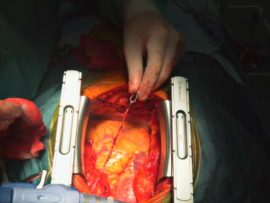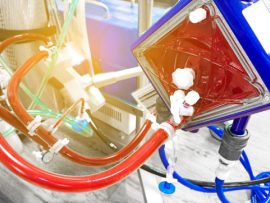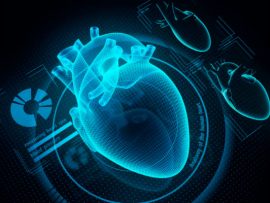Abstract Editor’s Perspective What We Already Know about This Topic Major bleeding can occur during cardiac surgery. Although different scoring systems exist, the assessment of bleeding can be variable, and..
Read MoreAbstract Background: Cardiac surgery on Jehovah's Witnesses (JW) can be challenging, given the desire to avoid blood products. Establishment of a blood conservation program involving the pre-, intra- and post-operative..
Read MoreAbstract Introduction: Accurate dosing of protamine reversal following on-pump cardiac surgical procedures is challenging, with both excessive and inadequate administration recognised to increase bleeding risk. We aimed to examine the..
Read MoreAbstract Background The role of inflammation in patients with coronary artery disease is emerging. We sought to assess the profile and outcomes of patients with a clinical syndrome of severe systemic..
Read MoreAbstract In critically ill patients monitored with an arterial catheter, the arterial pressure signal provides two types of information that may help the clinician to interpret haemodynamic status better: the..
Read MoreAbstract Purpose: To define some of the most common characteristics of vascular hyporesponsiveness to catecholamines during septic shock and outline current therapeutic approaches and future perspectives. Methods: Source data were obtained from..
Read MoreAbstract Background: Vasopressin is essential for cardiovascular homeostasis, acting via the kidney to regulate water resorption, on the vasculature to regulate smooth muscle tone, and as a central neurotransmitter, modulating..
Read MoreAbstract Objective: To define systemic release kinetics of a panel of cytokines and heat shock proteins in porcine polytrauma/hemorrhage models and to evaluate whether they could be useful as early trauma biomarkers...
Read MoreAbstract Vasoplegia is a ubiquitous phenomenon in all advanced shock states, including septic, cardiogenic, hemorrhagic, and anaphylactic shock. Its pathophysiology is complex, involving various mechanisms in vascular smooth muscle cells..
Read MoreAbstract Survival analysis incorporates various statistical methods specific to data on time until an event of interest. While the event is often death, giving rise to the phrase ‘survival analysis’,..
Read MoreAbstract Background Acute normovolemic hemodilution (ANH) is considered safe and effective in decreasing perioperative transfusion in paediatric populations undergoing high blood‐loss surgeries. We determined the association between ANH and the..
Read MoreBackground Heparin resistance (HR) is often encountered during cardiovascular operations that require cardiopulmonary bypass. Clinical risk factors and the mechanism underlying heparin resistance are yet to be determined. The aim..
Read MoreAbstract Background There is still uncertainty about the safety of aprotinin for coronary artery bypass graft surgery. The ART (Arterial Revascularization Trial) was designed to compare survival after bilateral versus..
Read MoreAbstract Background When comparing effects of on- versus (CABG), it is important to assess the long-term clinical outcomes. However, most research conducted thus far has concentrated on short-term outcomes and ignored..
Read MoreAbstract Introduction: Residual pump blood from the cardiopulmonary bypass (CPB) circuit is often collected into an infusion bag (IB) and re-transfused. An alternative is to chase the residual blood into..
Read MorePulmonary hypoplasia is common in the perinatal period and a significant cause of death in newborn infants. Wigglesworth and Desai reported an incidence of 14.5% in a series of perinatal..
Read MoreAbstract Congenital diaphragmatic hernia (CDH) is typified morphologically by failure of diaphragmatic development with accompanying lung hypoplasia and persistent pulmonary hypertension of the newborn (PPHN). Patients who have labile physiology..
Read MoreAbstract Pediatric cardiovascular services are responding to the dynamic changes in the medical environment, including the business of medicine. The opportunity to advance our pediatric cardiology field through collaboration is..
Read MoreAbstract Introduction: Prophylactic intra-aortic balloon counterpulsation (pIABC) is recommended for high-risk patients undergoing coronary artery bypass grafting (CABG) surgery. Criteria for high-risk patients benefiting from pIABC are unclear. This study..
Read MoreAbstract Extracorporeal membrane oxygenation (ECMO) has been used increasingly for both respiratory and cardiac failure in adult patients. Indications for ECMO use in cardiac failure include severe refractory cardiogenic shock,..
Read MoreAbstract Vascular hyperpermeability is a frequent intractable feature involved in a wide range of diseases in the intensive care unit. The glycocalyx (GCX) seemingly plays a key role to control..
Read MoreObjective The aim was to evaluate the predictive value of for in adult cardiac surgery with . Design Retrospective and systematic review of the literature. Setting A tertiary university hospital. Participants 202 patients undergoing..
Read MoreSummary Anaemia is common before cardiac surgery and is associated with increased morbidity and mortality. The World Health Organization (WHO) definition of anaemia is lower for women than for men..
Read MoreAbstract Summary Development and standardization of fibrinolysis methods have progressed more slowly than coagulation testing and routine high‐throughput screening tests for fibrinolysis are still lacking. In laboratory research, a variety..
Read MoreBackground Various techniques have been employed for the early detection of perioperative cerebral ischaemia and hypoxia. Cerebral near‐infrared spectroscopy (NIRS) is increasingly used in this clinical scenario to monitor brain..
Read MoreAbstract OBJECTIVES To develop a model for predicting long-term survival following coronary artery bypass graft surgery. METHODS This study included 46 573 patients from the Australian and New Zealand Society of..
Read MoreAbstract The aim of this study was to evaluate the impact of blood transfusion on bloodstream infections. This study included 2764 patients who underwent isolated coronary artery bypass grafting. Blood..
Read MoreAbstract OBJECTIVES To evaluate the efficacy of intensive craniocervical screening before elective cardiovascular surgery. METHODS A retrospective analysis of 1134 consecutive patients who underwent routine screening before cardiovascular surgery between..
Read MoreBackground: Glutamine is the most abundant free amino acid in the body. It modulates immune cell function and is an important energy substrate for cells in critically ill patients. Reduction..
Read MoreThe Task Force for the Management of Valvular Heart Disease of the European Society of Cardiology (ESC) and the European Association for Cardio-Thoracic Surgery (EACTS)
Read More


















